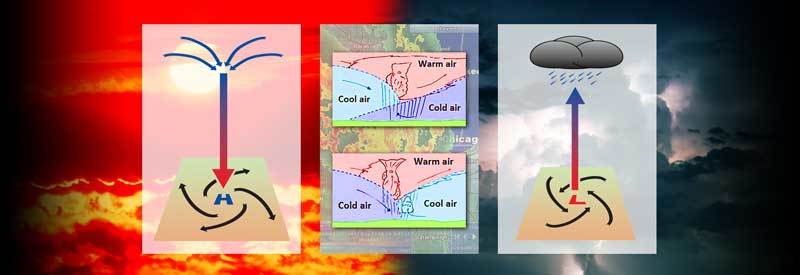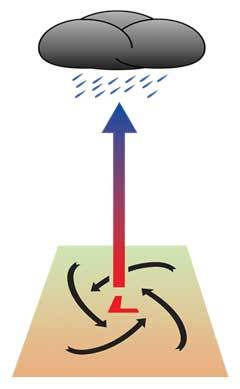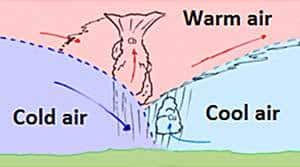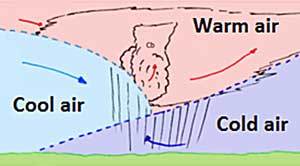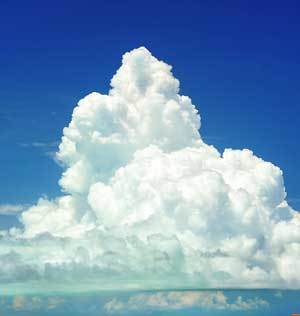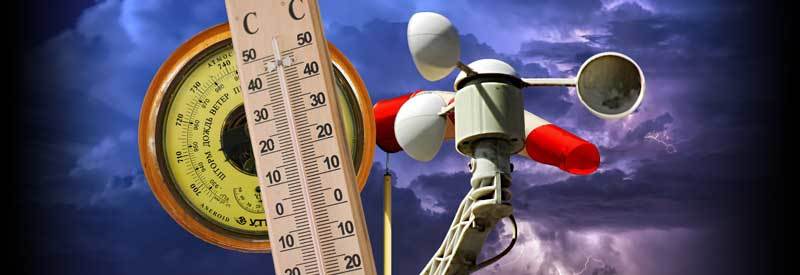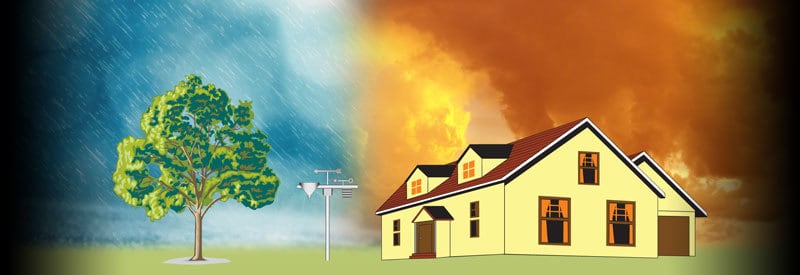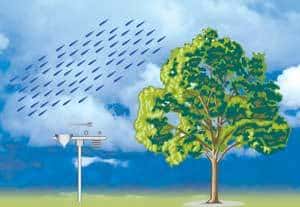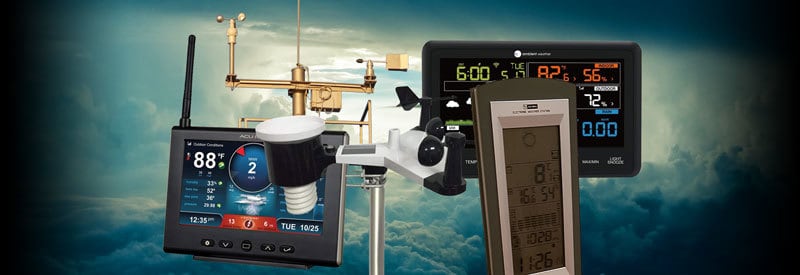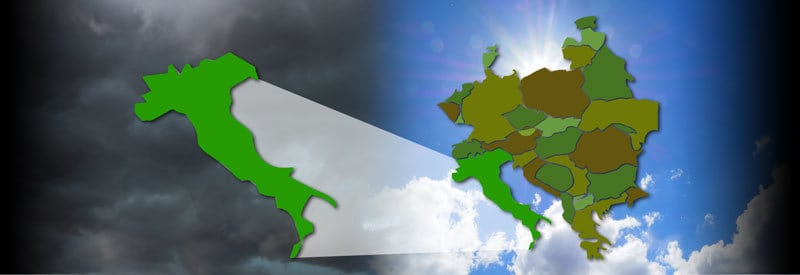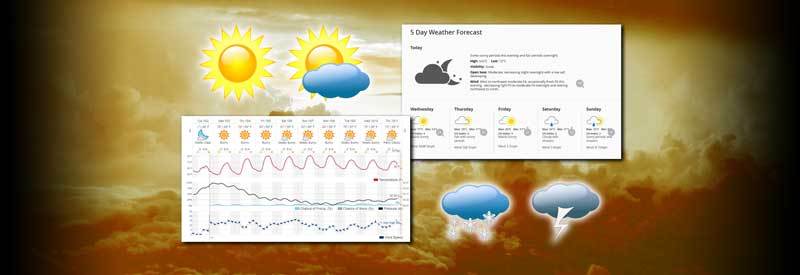
Most readers will more than welcome the ability to forecast the weather up to a month in advance. Unfortunately, this is not possible. Not yet, anyway. But how far ahead can a weather forecast be made?
There is absolutely no doubt that today's weather forecasts are vastly improved and more accurate & reliable than those from thirty years ago. And it continues to improve.
A wealth of historical data, better forecast models, a vast array of atmospheric sensors (on and above the Earth), and technological advances are all making remarkably precise weather predictions possible.
Even with all these advancements, there are still limitations on how far weather conditions can be forecasted or predicted in advance.
How Far Ahead The Weather Can Accurately Be Forecasted

The weather can be predicted with a high degree of accuracy up to five days in advance. The vast majority of meteorologists agree on this period, and some weather experts even feel confident that weather tendencies can be forecasted with a fair amount of accuracy for up to ten days in advance.
But there are limitations. Not so much in the accuracy, but more in the length of time weather can be predicted into the future. Not so long ago, a popular weather service (who will remain nameless) widely used on mobile devices around the world started issuing 90-day weather forecasts!
Needless to say, this move caused widespread shock and unanimous condemnation among meteorologists and climatologists alike. And with very good reason...
No matter how far and advanced weather predictions have become, there are simply too many variables influencing current and future weather conditions to make these extreme long-term forecasts accurate or even possible. These variables can appear or change in a very short time and, in many instances, are impossible to predict.
To understand why forecasting weather over a period of a month or more is not just unrealistic, but for all intents and purposes basically impossible, we need to look at some of the elements that can unexpectedly change weather conditions in a short period of time.
Why Long-Term Forecasts Are So Difficult
Forecasting weather more than 10 days into the future is seen by many weather experts as a calculated guess at best. There several factors making long-term predictions very tricky.
1) Different Forecasting Models
The first factor is a simple question of who you want to believe. If you are not a weather enthusiast, you probably are not aware that there are two major weather forecasting models many meteorologists rely on to track and forecast weather conditions: The European and American Weather Forecasting Models.
Both models use a wealth of historical and current weather data from around the world that are inputted into their weather models. However, the 2 models use different algorithms to process the data and calculate future weather conditions.

The European Model has always been seen as slightly superior and the more accurate of the two models. When the two models agree on the weather outcome, it's a positive reinforcement for all involved.
It is when the two models predict substantially different weather conditions that some controversy and difficulties arise. Every meteorologist has their own preference as to which model they trust. And completely relying on the wrong model can have far-reaching results.
(In 2012, the American Model forecasted that Hurricane Sandy would die down over the ocean, while the European Model predicted it would hit the East Coast. We are all too aware of the devastation and loss of life as a result of Sandy slamming into the American Coastline.)
This is not to say that one model is always superior to another one. It just goes to show that things are not as simple as it seems.
Then we still have to deal with the "Biggest Culprit" influencing weather forecasts...
2) The Chaotic Nature Of The Weather
The earth's atmosphere and the weather systems operating within it is just naturally chaotic and unpredictable. In other words, meteorologists are constantly trying to predict something that is, for all intents and purposes, unpredictable.

We have more weather satellites with better imagery sensors orbiting the earth than ever before. We have access to a wealth of historical and current data, and computers able to perform millions of calculations per second (more than a 2.89 quadrillion to be a bit more precise) to process all this data. So yes, weather forecasts have become very accurate and reliable.
But there are just too many small undetectable variables that can have a huge impact on the weather over the long term.
Just bear with me as I use the following analogy to explain it properly...
Most of you would have heard of the Butterfly Effect. But I will bet most of you don't know where the term originated from...
In 1961, after inputting a very small miscalculation into a weather model and realizing how big a difference it made to the forecasted weather, meteorologist Edward Lorenz noted in a paper that "one flap of a seagull’s wings could change the course of weather forever."
Over time this morphed into the now well-known "Butterfly Effect".
Ok, long story short, the smallest little weather phenomenon (like the slightest change in wind direction or a small drop in temperature) that will not even be able to be picked up by a weather sensor can have a ripple effect and end up in large-scale weather events in the future.
And like a ripple growing larger in a pond, the further it stretches over time, the bigger its effect on the weather. This analogy will help you better understand why short-term weather forecasts are much more accurate than trying to predict weather conditions in a month's time.
Are you still with me? Good!
3) Other Factors Influencing Long-Term Predictions
Apart from the 2 previously mentioned factors that make long-term weather forecasts (e.g. 30-day or 90-day forecast) unreliable and inaccurate, there are weather variables and phenomena which behavior may unexpectedly change or not change.
This can lead to weather conditions that differ substantially from what a long-term weather forecast may suggest. Here is just a few examples:
Temperature
Temperature has a huge impact on the weather and sometimes are the main driving force of large weather systems. We are very unaware of the amount of weather element influence the temperature around us. We see a clear, cloud-free day and immediately think of warmer temperatures.
There are dozens of unpredictable forces influencing the weather around us though. For example, a solar flare at the sun's surface millions of miles away, can cause the surface of part of the ocean to rise by a fraction of a degree.
This seemingly insignificant change is big enough to completely change weather systems and their forecasted behavior in the affected region. It may cause weather conditions to die away or intensify and become much more severe.
There is obviously a lot more complex processes involved in the changes of temperature, but this is just one example of how one unpredictable event can make long-term forecasts almost impossible by changing one of its biggest driving forces, temperature.
Air Movement (Wind)
Wind, also a major driver of major weather systems, is influenced to a large extend by temperature. And as we have just seen, the temperature can be very fickle and at the mercy of many unpredictable forces.
As a result, wind patterns can be unexpectedly influenced to a smaller or larger extent.

At the convergence of ocean and land, offshore and onshore winds may change, causing approaching weather systems to reach land or stay over the ocean.
In more severe cases, the additional heat over the surface temperature of the ocean water in the Tropics may cause a tropical depression to strengthen to a tropical storm or even a hurricane due to the increase in wind speed.
Almost all of these events just mentioned would have been completely "ignored" by long-term weather forecasts that were issued long before the unexpected change in wind direction and speed even occurred.
Global Warming
Yes, this is a very controversial topic, but I trust if you are reading this article, you don't need to be convinced of the dangers and devastating consequences it poses. (We are already seeing its impact during recent years in ever-increasing extreme weather events.)
Apart from the physical evidence we see on a yearly basis, global warming is also making consistent long-term forecasts very difficult. It is impacting the weather on so many levels that I am just going to highlight one prominent weather phenomenon to illustrate the point: Jet Streams.
As mentioned in an earlier article (which you can read here), Jet Streams are long narrow bands of high-speed speed winds, circulating the earth at high altitudes.
The 2 Jet Streams at the North and South Pole respectively, have a huge impact on global weather patterns. They don't flow in a straight line, but rather in a meandering way with high and low points, resulting in warm, cold, dry, and wet weather as they interact with different weather systems and the earth's surface below them.
Global Warming at both Poles (which is resulting in the breaking up of the ice caps and warmer ocean water temperature), is having a huge influence on the 2 Jet Streams above them.
A notable weakening of these winds, as well the development of a wobble in the flow, are two disturbing patterns that is a result of this influence. The wobble in the flow is having a severe and prolonged impact on the regions they effects, causing severe conditions like cold snaps, heatwaves, and flooding.
These weather conditions are very unpredictable, and making weather forecasts, especially long-term predictions, very difficult for meteorologists. And these occurrences are getting more common and widespread globally.
So How Far Ahead Can Weather Be Accurately Predicted
So how far ahead can weather then be realistically be predicted. It depends to a large extent how accurate a weather forecast you want to get.

As already stated at the beginning of the article, meteorologists agree that weather can be predicted with a relatively high degree of accuracy for up to five days into the future. Most weather experts even feel confident that weather tendencies can be forecasted to a certain degree of accuracy for up to ten days in advance.
Emphasis should be placed on the fact that the latter "forecast" this far into the future should be seen as a prediction into the "weather tendency or direction" rather than actual weather conditions during this period.
As already stated, the weather can be predicted with much more accuracy today than 20 years ago, which in turn was much more accurate than the previous 20 years. And it will keep on improving, but incrementally and mostly in accuracy, not so much in length of time.
For example, today, we can make a 5-day weather forecast with the same amount of accuracy a 3-day forecast was made in the 1990s. Similarly, we can make a fairly accurate prediction of future weather tendencies up to 10 days in advance, compared to a maximum of a week in the early 1980s.
Conclusion
Ok, as you can clearly see, predicting the weather is not as simple as you might have thought. It is literally taking millions of bits of data from weather stations around the world, buoys in the ocean, satellites in the sky, and combining that with historical data to be fed into complex weather forecasting system to give us surprisingly accurate forecasts.
Do they get it wrong? Off course. But this is not due to bad weather forecasting, but mostly due to unforeseen events, some of which I highlighted in this article. Rest assured, weather forecasting keeps on improving, and we are way better off than a few decades ago!
However, making bold predictions far into the future is a horse of a different color altogether. The "dark art" of trying to forecast the weather a month in advance (or 90 days in some weather service's case) is a very risky business and a bit ambitious at best.
I went to great lengths throughout this post to highlight all the different factors that make it almost impossible to accurately forecast weather over such a long period.
At some point in the future, we may be able to detect and include many of these "unpredictable events" into our forecasting models, but we still have a long way to go.
So no, as much as I love and encourage everyone to get their own home weather station, they will NOT be able to tell you how to dress 3 months from now...
Never miss out again when another interesting and helpful article is released and stay updated, while also receiving helpful tips & information by simply clicking on this link .
Until next time, keep your eye on the weather!
Also Read


